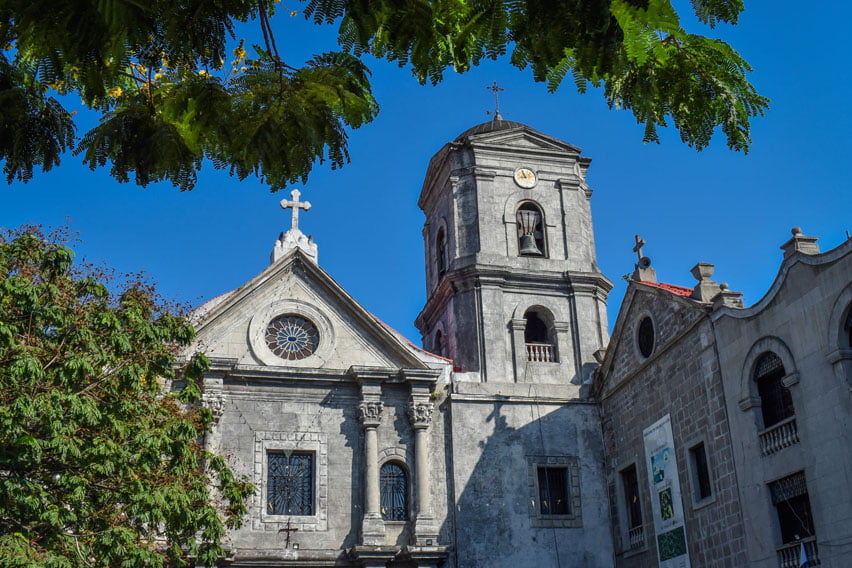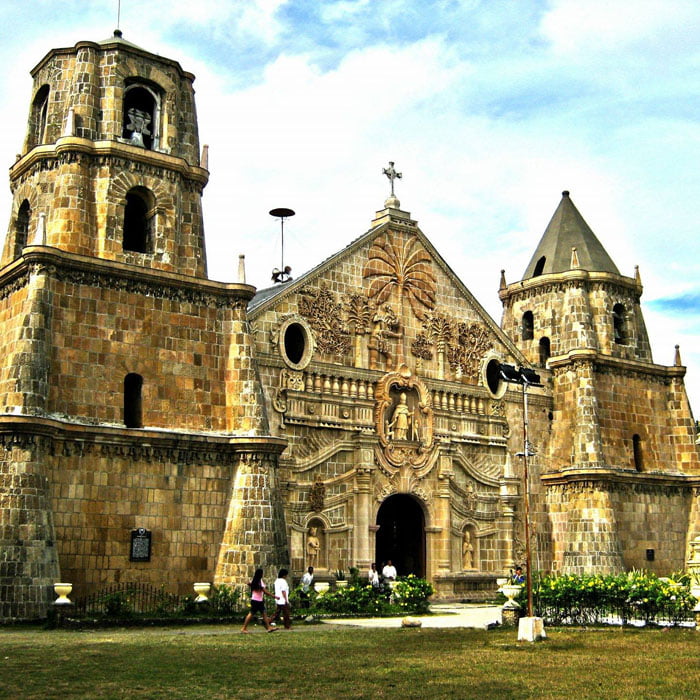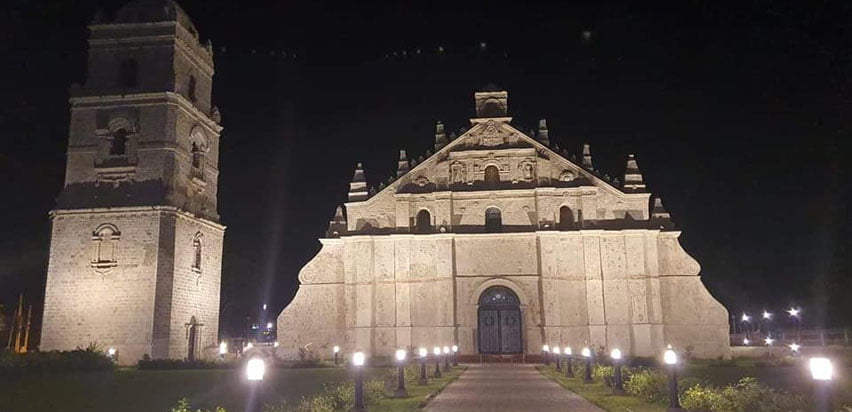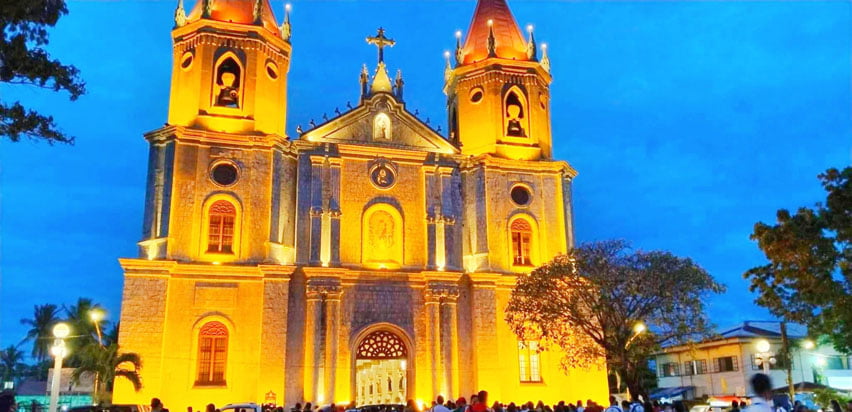Two years ago, Catholics all over the Philippines celebrated 500 years of Christianity in the country. The roots of our faith can be traced back to March 16, 1521, when Ferdinand Magellan held Mass at Limasawa, Leyte. The centuries that followed saw Spanish friars building churches throughout the country as they continued to spread the faith.
Many of those churches still stand today and are filled to capacity as the faith continues to thrive in this predominantly Catholic country. Especially during Holy Week or the Lenten season, the faithful go on pilgrimages to visit iconic churches around the country. Let this be your guide for the next time you visit the motherland.
Baroque Churches in the Philippines
This is the collective term for four Spanish-colonial era churches in the country that were included in UNESCO’s World Heritage List in 1993. With their inclusion in the list, these churches are also considered national cultural treasures.
1. San Agustin Church, Manila
Location: General Luna St., Intramuros, Manila

Third time’s the charm for the Spaniards who decided to build San Agustin Church after their first two structures were damaged by fire. The first church was built using bamboo and nipa in 1571, then the second wooden church caught fire in 1573. Construction of the present stone church began in 1586 and was completed in 1607. The church has survived countless wars and natural disasters, thanks to constant renovations, the latest of which was in 2013.
As the oldest stone church in the country, San Agustin Church has held a prominent place in our history. During the Second World War, Japanese troops turned the church into a concentration camp. It was the only church in Intramuros to survive the Battle of Manila. The church also has a crypt and niches that hold the remains of historical figures like Miguel Lopez de Legazpi (who declared Manila as the capital of the Philippines), artist Juan Luna, and historian Teodoro Agoncillo.
2. Miagao Church, Iloilo
Location: Zulueta Avenue, Miagao, Iloilo

The parish of Miagao was first established in 1731, but the former location of its church and convent was vulnerable to frequent Moro invasion. In 1787, a new church with thick stone walls befitting a fortress was built on the highest point of the town to guard against potential invaders. It took ten years for construction to finish, and it has since been rebuilt and renovated after being damaged by wars and earthquakes. The latest restoration efforts were in 1962.
It got its distinctly ochre color from the materials used to construct the church: adobe, coral, limestone, and egg—which townsfolk were supposedly forced to donate along with their labor.
Santo Tomas de Villanueva is the church’s patron saint, and they celebrate his feast day on September 22. Miagao also holds a Salakayan Festival during the first week of February.
3. Paoay Church, Ilocos Norte
Location: Marcos Ave., Paoay, Ilocos Norte

The earliest historical record dates the Paoay Church to as far back as 1593, but construction of the present structure started in 1694 and was finished in 1710. Those in charge of constructing the church recognized how the Ilocos region was prone to earthquakes, and so built the Paoay Church with 24 buttresses along its side and back exterior walls. While these buttresses are architectural structures that support and reinforce the walls, they have also become the church’s most striking feature.
The Paoay Church is also known for having a belltower that is detached from the church—unlike most other churches in the country—since it was added several years after the church was completed as added protection from earthquakes. The belltower was used as a lookout in significant points of history: by the Katipuneros in the 1896 revolution and by Filipinos during World War II.
Also known as St. Augustine Parish, the Paoay Church is always open, but it’s best to visit in the afternoon if you want a great photo of the church’s facade.
4. Santa Maria Church, Ilocos Sur
Location: 4 Santa Maria – Burgos Rd., Santa Maria, Ilocos Sur
Getting to the Santa Maria Church feels like you’re climbing a stairway to heaven. After all, the church was built on a hill back in 1765. But climbing the 85-step stairway made of granite rock is worth it, as it opens up to a courtyard in front of the church doorway, giving you a great view of the church’s facade. Surrounded by defensive walls on all sides, the Santa Maria Church also has a detached four-storey bell tower and a convent located in front of the church, connected to the main structure by an elevated stone walkway.
The Santa Maria Church was dedicated to the Virgin Mary under the title of Our Lady of the Assumption, which is why it is known as the Santuario de Nuestra Señora de la Asuncion Church. The church celebrates the Feast of the Assumption on August 15.
Other Churches in Luzon
5. Manila Cathedral, Manila
Location: Cabildo cor. Beaterio Sts., Intramuros, Manila
Originally constructed as a parish church in 1571, the Manila Cathedral that stands in Intramuros today is actually the eighth structure built throughout the church’s history. Construction of the present building was completed in 1958.
The cathedral has 134 stained-glass windows created by Filipino artist Galo Ocampo, who decided on a Marian theme since the Immaculate Conception of Mary is the patroness of the Archdiocese of Manila and Manila Cathedral. The windows depict significant moments of the Christian faith.
With a long history of being destroyed and rebuilt, the Manila Cathedral also uniquely highlights its own story as a church with eight bronze panels installed in its main portal. The church also offers guided tours to let visitors better appreciate its history as one of the oldest churches in the country.
6. Taal Basilica, Batangas
Location: Calle San Martin, Taal, Batangas
When the first structure built in 1575 was destroyed by the eruption of Taal Volcano, Spanish friars decided to construct a new structure at the present site of Taal Basilica. That had been damaged by an earthquake, and work on the present structure was finally completed in 1878.
The Taal Basilica is renowned for being the largest church not only in the Philippines, but in the entire Asia. It stands at 88.6 meters (291 ft) long and 48 meters (157 ft) wide, and the interior’s high ceilings only emphasize the basilica’s spaciousness. Some of the unique features of its design include the facade’s use of coral stone quarried from Taal Lake, the painting of Christ’s Ascension found in the dome interior, and intricate capiz windows throughout the church.
Also known as the Minor Basilica of Saint Martin of Tours, the Taal Basilica celebrates the feast day of Saint Martin of Tours on November 11. Visit the church in the morning or early afternoon to avoid the crowds and take great photographs.
7. Barasoain Church, Bulacan
Location: Paseo del Congreso Street corner Don Antonio Bautista Street, Brgy. San Gabriel, Malolos, Bulacan
The Barasoain Church may be familiar to the older generation as the church featured on the back of the 10-peso bill back in the day, and that only goes to show how important the church is to our country’s history. It was the site of the historic First Philippine Congress, which was convened to draft what became known as the Malolos Constitution in 1899. This led to the inauguration of Emilio Aguinaldo as the country’s first president, and this is why the Barasoain Church has been called “Cradle of Democracy in the East, the most important religious building in the Philippines” in history books.
As the church is also known as the Our Lady of Mount Carmel Parish, the Barasoain Church celebrates the feast day of Our Lady of Mount Carmel on July 16, and the feast day of all Carmelite Saints on November 14.
8. Betis Church, Pampanga
Location: San Nicolas 2nd, Betis, Guagua, Pampanga
Get ready to crane your neck toward the ceiling when you visit Betis Church, known as the Sistine Chapel of the Philippines. While the church was built in 1660, the beautification of its interior was spearheaded by the church’s last Spanish priest, Fr. Santiago Blanco, in 1939.
Filipino painter Macario Ligon was commissioned to paint the church’s ceilings with selected Biblical scenes, the Holy Family, and Catholic saints and cherubs. In the ‘70s, these ceiling paintings were restored by his nephew and assistant Victor Ramos.
To get the best view of the ceiling, visit Betis Church in the morning when the church is bathed in natural light. You may also visit on July 25 and December 30, two feast days celebrated in honor of St. James the Apostle, as the church is also known as Santiago Apostol Parish or the Parish Church of Saint James the Apostle of Betis.
Churches in Visayas and Mindanao
9. Santo Niño Basilica, Cebu
Location: Pilgrim’s Center, Osmeña Blvd., Cebu City
As the story goes, Christianity came to the Philippines when Ferdinand Magellan gave an image of the Child Jesus to the wife of Rajah Humabon when they were baptized in 1521. After forty years, that image was found by a Spanish soldier, and this paved the way for the founding of what is now the Santo Niño Basilica, the oldest Roman Catholic church in the Philippines.
It was established in 1565, and after the past structures were destroyed and rebuilt, the present church was finished in 1740. Pope Paul VI declared the church a basilica in 1965, calling it “the symbol of the birth and growth of Christianity in the Philippines.”
The Feast of the Santo Niño is celebrated with the Sinulog Festival on the third Sunday of January, so it’s a great time to visit and be part of the celebration and festivities. Throughout the year, many devotees make pilgrimages to the basilica, so much so that a pilgrim center was constructed within the church compound.
Located a stone’s throw away from the Santo Niño Basilica is Magellan’s Cross, and just two blocks north is the Cebu Metropolitan Cathedral, which is the seat of the Roman Catholic Archdiocese of Cebu. You can maximize your visit to the Santo Niño Basilica by dropping by these historical and religious landmarks, too.
10. Baclayon Church, Bohol
Location: Poblacion, Baclayon, Tagbilaran City, Bohol
When a devastating earthquake hit Bohol in 2013, many of the Catholic faithful were dismayed to learn that the historic Baclayon Church was heavily damaged. The damage was so extensive that the church was removed from consideration to be included in the UNESCO World Heritage Sites of the Philippines alongside other Jesuit churches in the country.
The Diocese of Tagbilaran and the National Historical Commission of the Philippines worked on restoring the church until it reopened to the public in 2018. This was the latest restoration work done on the church that had been established in 1596 and was destroyed and restored many times throughout its history. Because the church’s original facade crumbled in the earthquake and left the interiors exposed to the street, the restoration included building a new facade, bell tower, and altar.
Also known as the Immaculate Conception Parish, Baclayon Church celebrates the town’s fiesta on December 8, the Feast of the Immaculate Conception.
11. Molo Church, Iloilo
Location: 132 San Pedro St., Molo, Iloilo City

Unlike most Catholic churches that feature the Crucified Christ at the center of its altar, Molo Church has a statue of its patroness St. Anne as its centerpiece. With two rows of 16 female saints that line the church interiors, it’s no wonder that Molo Church has been dubbed as a “feminist church” or “women’s church.”
Established in 1863, Molo Church once housed biblical paintings that Jose Rizal came to see in 1886. It has withstood countless storms and earthquakes, and even served as an evacuation center during World War II.
Molo Church is also renowned for being the only Gothic church in the country outside of Metro Manila. It has a white coral stone facade and two bell towers with spires and pointed arches. Visit the church in the late afternoon to see how the coral facade reflects the golden rays of the sunset, a sight to behold from the vantage point of Molo Plaza.
Also known as Sta. Ana Parish of Molo or Saint Anne Parish Church, Molo Church celebrates the feast day of St. Anne on July 26.
12. Caraga Church, Davao Oriental
Location: Surigao-Davao Coastal Road, Poblacion, Caraga, Davao Oriental
Not all old churches in the Philippines are majestic and grandiose. A simple structure built by the sea, Caraga Church is the oldest church in Mindanao, as it also sits in one of the oldest towns in Davao Oriental. The Jesuits started constructing the church in 1877 to serve as a mission station for Spanish missionaries who were spreading Christianity in Mindanao. Construction was completed in 1884, and the church was dedicated to San Salvador del Mundo, Jesus Christ’s title as Savior of the World.
Since the church looks out to the Pacific Ocean, it was designed as a fortress church and used as a watch tower to guard against raiding pirates. Caraga Church was also miraculously spared from any damage when a devastating typhoon hit the region in 2012.
Caraga Church has been restored many times through the years, the most recent of which was a two-year restoration project that saw the church reopening in 2020. The church still has a few artifacts left over from the Spanish era, such as 200-year-old giant seashells that are used as holy water fonts, the baptismal font found at the Holy Door of San Salvador del Mundo Parish, and an antique statue of San Isidro Labrador, the town’s patron saint.
